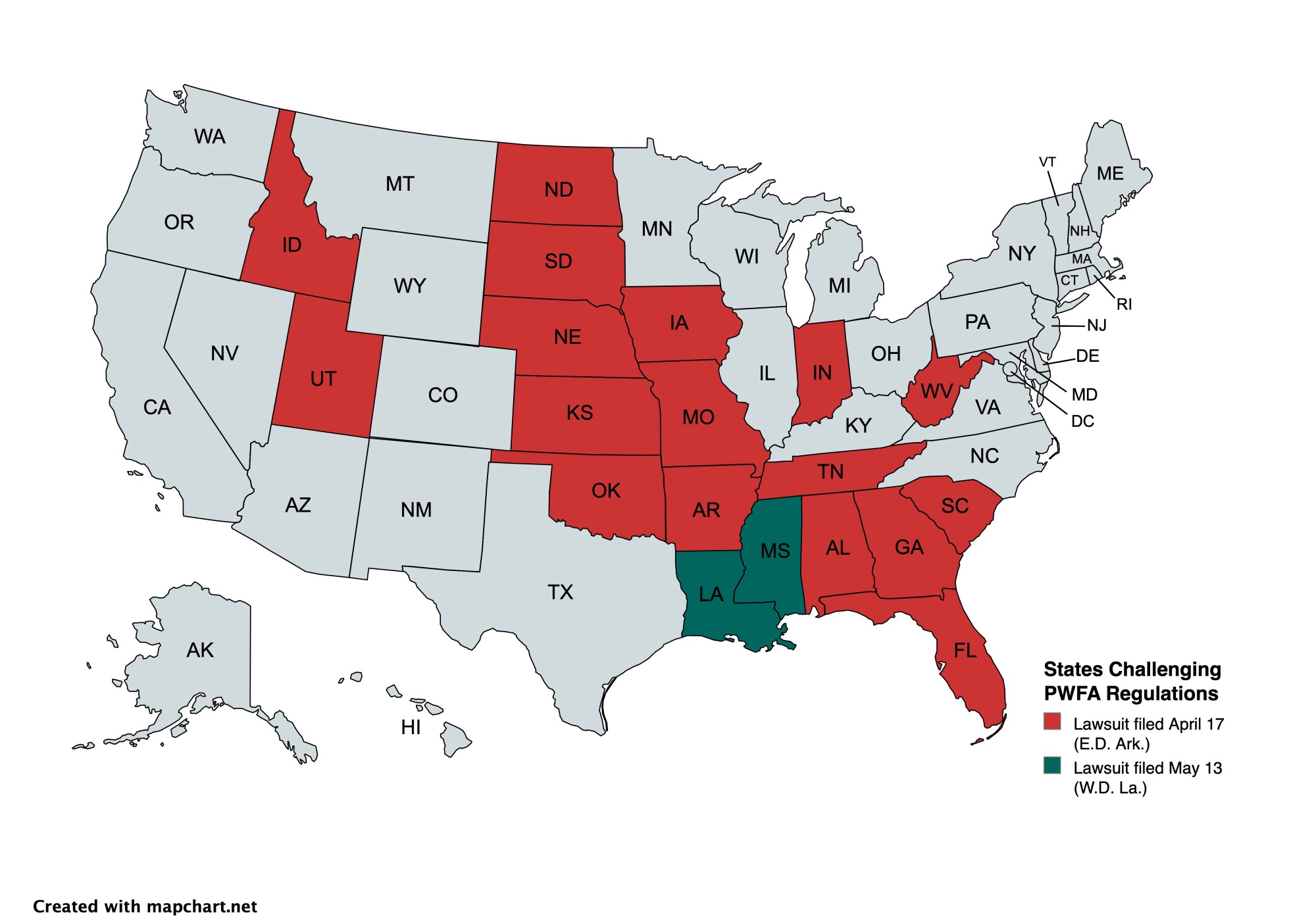As previously discussed, on June 18, 2024, California’s political leaders announced a tentative deal to reform a number of aspects of California’s Private Attorneys General Act (“PAGA”). On June 27, 2024, the PAGA reform bills, Senate Bill 92 and Assembly Bill 2288, were approved by the California Legislature and on July 1, 2024, Governor Newsom signed both bills into law. The PAGA reform bills contain urgency clauses such that the bills take effect upon signing. Both bills explicitly apply only to PAGA claims filed on or after June 19, 2024, or those PAGA claims for which the required notice to California’s Labor Workforce Development Agency (“LWDA”) was filed on or after June 19, 2024. The PAGA reform bills add details to the previously announced key reform components of increased employee share of PAGA penalties, caps on penalties for employers who take steps to comply with the Labor Code or fix potential issues after receiving notice of a PAGA claim, and requiring the representative plaintiff to experience every alleged PAGA violation to have standing. These reform bills are likely to curb, but not eliminate PAGA litigation for California employers going forward.
The core elements of Senate Bill 92 and Assembly Bill 2288 are discussed further below:
Employee Share of Penalty
Currently, any PAGA penalties awarded, after attorney’s fees and costs are subtracted, are apportioned 75% to the California Labor Workforce Development Agency, and the remaining 25% is distributed amongst the aggrieved employees. AB 2288 amends Section 2699 to increase the aggrieved employees’ share of the penalties to 35%.
Increased Penalties for Malicious Employer Conduct
AB 2288 amends Section 2699(f) to increase the PAGA penalty to $200 per pay period for instances where an employer acted “maliciously, fraudulently, or oppressively” or the employer’s applicable policy or practice was previously found to be unlawful within the preceding 5 years. AB 2228 does not specify what conduct constitutes malicious, fraudulent, or oppressive conduct, though this language is similar to the standard for punitive damages applicable to non-wage and hour employment claims.
General Caps on PAGA Penalties
AB 2288 also amends Section 2699(f) to reduce the PAGA penalty to $25 per pay period for violations of Labor Code Section 226 (which requires employers to provide accurate wage statements to employees), if the employee could promptly and easily determine from the wage statement alone the accurate information.
AB 2288 further amends Section 2699(f) to reduce PAGA penalties for any alleged violation to $50 per pay period if the alleged violation resulted from an “isolated, nonrecurring event” that did not extend beyond the lesser of 30 consecutive days or four consecutive pay periods.
AB 2288 also creates Section 2699(i), which prohibits recovery of PAGA penalties for violations of: (1) the final pay provisions of the Labor Code (Sections 201, 202, or 203) or the timely payment provisions (Section 204) when the violations are neither willful nor intentional; or (2) Labor Code Section 226 that are neither knowing nor intentional or a failure to provide a wage statement. Section 2699(i) thus brings PAGA into alignment with the recent California Supreme Court decision in Naranjo. Section 2699(i) also permits a court to reduce any PAGA penalty in situations where the same conduct or omission resulted in multiple alleged violations of the Labor Code, likely reducing the possibility for “stacked” PAGA penalties arising from a single payroll or policy error.
Caps on PAGA Penalties for Proactive Compliance
AB 2288 creates Section 2699(g), which limits PAGA penalties to a maximum of 15% of the applicable PAGA penalty for employers who, before receiving an LWDA notice or a request for employee records from a representative plaintiff or their counsel, have “taken all reasonable steps to be in compliance with all provisions” of the Labor Code allegedly violated. “All reasonable steps” may include, but is not limited to:
- conducted periodic payroll audits and took action in response to the results of the audit;
- disseminated lawful written policies;
- trained supervisors on applicable Labor Code and wage order compliance; or
- took appropriate corrective action with regard to supervisors.
Whether the employer’s conduct was reasonable will be evaluated by the totality of the circumstances and will take into consideration the size and resources available to the employer, and the nature, severity and duration of the alleged violations. The existence of a violation, despite the steps taken, is insufficient to establish that an employer failed to take all reasonable steps.
Note that the 15% penalty cap does not apply where an employer acted “maliciously, fraudulently, or oppressively” or the employer’s applicable policy or practice was previously found to be unlawful within the preceding 5 years. Also, AB 2288 specifically provides that a court may exceed the 15% penalty cap if, based on the facts and circumstances of the particular case, to do otherwise would result in an award that is unjust, arbitrary and oppressive, or confiscatory.
Newly created Section 2699(j) provides that PAGA penalties cannot be awarded against an employer who proactively complies with the Labor Code for those violations the proactive employer “cures” after receiving an LWDA notice.
Caps on PAGA Penalties for Remediation
AB 2288 creates Section 2699(h), which limits PAGA penalties to a maximum of 30% of the applicable PAGA penalty for employers who take steps to fix policies and practices after receiving an LWDA notice. The employer must take “all reasonable steps” to prospectively be in compliance with all provisions identified in the notice within 60 days of receiving an LWDA notice. “All reasonable steps” may include, but are not limited to, taking an action to initiate any of the following:
- conduct an audit of the alleged violations and take action in response to the results of the audit;
- disseminate lawful written policies as to the alleged violations;
- train supervisors on applicable Labor Code and wage order compliance; or
- take appropriate corrective action with regard to supervisors.
Whether the employer’s conduct was reasonable will be evaluated by the totality of the circumstances and will take into consideration the size and resources available to the employer, and the nature, severity and duration of the alleged violations. The existence of a violation, despite the steps taken, is insufficient to establish that an employer failed to take all reasonable steps.
Note that the 30% penalty cap does not apply where an employer acted “maliciously, fraudulently, or oppressively” or the employer’s applicable policy or practice was previously found to be unlawful within the preceding 5 years. Also, AB 2288 specifically provides that a court may exceed the 30% penalty cap if, based on the facts and circumstances of the particular case, to do otherwise would result in an award that is unjust, arbitrary and oppressive, or confiscatory.
Newly created Section 2699(j) provides PAGA penalties cannot be awarded against an employer who undertakes timely remediation for those violations that the employer “cures” after receiving an LWDA notice.
Other Penalty Reductions
AB 2288 creates Section 2699(o), which halves the applicable PAGA penalties if the employees’ regular pay period is weekly rather than biweekly or semimonthly. This equalizes penalties for those employers who pay their employees on a weekly basis, as opposed to bi-weekly. PAGA penalties are currently assessed on a per pay period basis, making employers who utilize weekly payroll potentially subject to double the amount of PAGA penalties as an employer paying bi-weekly.
Cure Opportunities to Avoid Litigation
Section 2699(d) currently provides an employer the opportunity to avoid liability if it properly “cures” the alleged Labor Code violation(s) by abating each alleged violation, coming into compliance with the Labor Code sections allegedly violated, and making any aggrieved employee “whole.” Further, to cure certain technical violations of Labor Code Section 226, an employer must currently re-issue corrected wage statements to all aggrieved employees for the past three years.
AB 2288 amends Section 2699(d) to clarify that an aggrieved employee is “made whole” when the employee has received: (1) an amount sufficient to recover any unpaid wages due dating back three years from the date of the LWDA notice, plus 7 percent interest; (2) any liquidated damages as required by statute; and (3) reasonable lodestar attorney’s fees and costs to be determined by the agency or the court. If there is a dispute over the amount of unpaid wages due, the employer may cure by paying the amount that could reasonably be owed based on the violations alleged in the LWDA notice.
AB 228 also enables violations of Labor Code Section 226 to be more easily cured by providing employees electronic access to corrected wage statements, instead of re-issuing them, or, in situations where the correct name and/or address of the legal employer was not listed, a summary of the corrected information and a list of the applicable pay periods.
Additional Cure Opportunities for Small Employers
SB 92 creates Section 2699(c)(2), effective October 1, 2024, which allows employers who employed less than 100 employees during the statute of limitations period of the alleged PAGA claims to submit a confidential proposal to the LWDA to “cure” any alleged violations under the newly amended Section 2699(d). If necessary, the LWDA may set a conference between the representative plaintiff and the employer to determine whether the proposed cure is sufficient, what additional information may be necessary to evaluate the sufficiency of the cure, and the deadline for the employer to complete the cure. The LWDA may also request the employer pay any proposed cure amount, including any wages and liquidated damages due and 7 percent interest, into escrow or shall provide such other form of security as the agency deems suitable. If the LWDA determines the employer has properly cured the alleged violation, the representative plaintiff may not proceed with their lawsuit. However, the representative plaintiff may request a hearing before the LWDA to contest the determination that the alleged violations have been cured, and then subsequently appeal the LWDA’s determination to the superior court.
Early Resolution Opportunities for Large Employers
SB 92 creates Section 2699(f)(1), which provides an early evaluation process for “large” employers who employed more than 100 employees during the statute of limitations period of the alleged PAGA claims. The early evaluation process includes a mandatory stay of litigation and diverts the parties to an early evaluation conference before a “neutral evaluator,” similar to an early mediation. In addition to the parties presenting their evidence and arguments regarding the liability and exposure, the employer must also present a proposed plan to “cure” any alleged violations if it intends to do so under the newly amended Section 2699(d). The early evaluation process is intended to last no more than 30 days.
Standing
Presently, under Kim v. Reins International California, Inc.(2020) 9 Cal.5th 73, a representative plaintiff has standing to bring a PAGA lawsuit so long as the plaintiff was employed by the alleged violator and personally suffered at any point in time at least one Labor Code violation on which the PAGA lawsuit was based.
AB 2288 amends Sections 2699(a) and (c) to provide that a representative plaintiff may now only bring suit to recover penalties on behalf of themselves and other current or former employees against whom a violation of the same provision of the Labor Code was committed. The representative plaintiff must also have actually experienced each of the alleged PAGA violations within the one-year statute of limitations for PAGA claims to have standing to pursue the litigation. Notably, AB 2288 excepts PAGA claims brought by certain existing nonprofit legal aid organizations from these new stricter standing requirements.
Manageability
Presently, under the California Supreme Court’s recent decision in Estrada v. Royalty Carpet Mills, Inc., trial courts lack inherent authority to strike PAGA claims on manageability grounds, even if those claims are complex or time intensive, unlike the authority that trial courts have to bar class action claims. AB 2288 creates Section 2699(p), which permits a trial court to limit the evidence at trial or the scope of any PAGA claim to ensure that the claim can be effectively tried. AB 2288 also creates Section 2699(q), which permits a trial court to consolidate or coordinate multiple PAGA suits that allege legally or factually overlapping violations against the same employer.
Conclusion
The PAGA reform deal is likely to curb, but not eliminate PAGA litigation for California employers going forward. The reformed PAGA makes it even more critical for employers to proactively monitor their California wage and hour compliance, as well as act swiftly to evaluate their options to fix or cure the alleged violations when they receive notice of a potential PAGA claim.




















